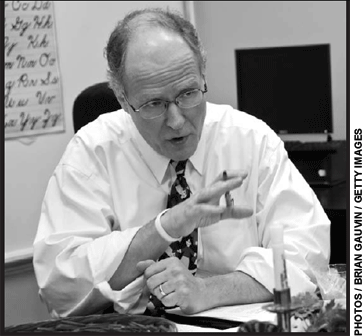 The 14-year-old in the discipline school, let’s call him Kareem, was having a bad day. He’d gotten into a food fight, and he was in big trouble. He didn’t want to face the principal and whatever punishment was going to be meted out. So he walked out of the school, at 26th and Jefferson streets in pockmarked North Philadelphia, trekked for nearly two miles through some of the city’s most dangerous streets, and presented himself at the front desk in the blond brick headquarters of the city school district.
The 14-year-old in the discipline school, let’s call him Kareem, was having a bad day. He’d gotten into a food fight, and he was in big trouble. He didn’t want to face the principal and whatever punishment was going to be meted out. So he walked out of the school, at 26th and Jefferson streets in pockmarked North Philadelphia, trekked for nearly two miles through some of the city’s most dangerous streets, and presented himself at the front desk in the blond brick headquarters of the city school district.
“I want to speak to Paul Vallas,” he announced.
The perplexed guards called the head of the district’s alternative schools office, a woman named Gwen Morris, who had worked in the system for more than three decades and before that had been a Philadelphia public school student herself.
Morris and a few other Vallas aides called the student’s mother and the school principal and efficiently sorted things out. But the boy kept insisting: he wanted to speak to Vallas.
Morris has seen way too much to be easily impressed by the putative saviors who come and go in urban schools. But she still sounds amazed when she tells this story. Even in the fog of his often troubled life, Kareem had heard of Vallas. He knew this building as the place where Vallas worked. And he had absorbed the gist of what Paul Vallas is reputed to be able to do: solve problems in urban schools. Make things better.
Little things. Big things. Of the cadre of non-educators—business leaders, military men, government officials, lawyers—who have been called on to transform large urban school districts in recent years, Paul Vallas has been at it the longest and, in the minds of many, is the one with the best track record. Since 1995, he has tackled the third- and eighth-largest districts in America—Chicago and Philadelphia. Both of them are old-politics big cities with school systems long steeped in racial tensions and marked by tough unions, deteriorating buildings, and white and middle-class flight. Intensifying poverty and racial isolation accompany escalating demands for better student outcomes.
Vallas lasted longer in both Chicago and Philadelphia than most urban school leaders, six years in Chicago and then five in Philadelphia, but he wore out his welcome in both places. He left the Philadelphia district in many ways transformed, most agree for the better, but still with a sour taste and a big deficit. While he won converts among longtime district staff for his energy and commitment, he alienated the people who hired him; things had become so bitter that he didn’t show up for his own sendoff. A similar thing happened in Chicago, where Mayor Richard Daley, who had installed him to clean up what had been described as the worst school district in America, eased him out after he had done just that.
The saga of Paul Vallas, to hear him tell it, is one of too much success.
“What happens with turnaround superintendents,” he said, “is that the first two years you’re a demolitions expert. By the third year, if you get improvements, do school construction, and test scores go up, people start to think this isn’t so hard. By year four, people start to think you’re getting way too much credit. By year five, you’re chopped liver.”
But Vallas has little time for reflection or looking back. He is focused on what may be his biggest challenge yet as superintendent of the Recovery School District (RSD) in the ruined city of New Orleans.
The powerbrokers in New Orleans are thrilled to have him. “He has vision, he has shown us what we can have, what can be accomplished,” said Penny Dastugue, a member of the Louisiana State Board of Elementary and Secondary Education, or BESE, which runs the RSD. “He’s really brought hope to so many and promise, and he delivers. He’s created buy-in from all parties, and that’s never existed in this city. We’ve been so divided along racial lines, along neighborhood lines. He’s been able to take us all above that and help us see what needs to be done. This is the first time I’ve been hopeful for the city and the children.”
The Philadelphia Story
Depending on whom you talk to, Paul Vallas is either a loose cannon or a genius; he is, in fact, a combination of the two. His energy level is boundless, his temper legendary, his gangly charm equally so. His style of leadership, the “Vallas treatment,” is by now well established. Do things big, do them fast, and do them all at once.
He arrived in Philadelphia in the summer of 2002, after a difficult, contentious year in which the state took over the city school district, declaring it bankrupt financially and academically. The governor at the time, Republican Tom Ridge, and the state legislature had been at war with the previous superintendent, David Hornbeck, over the adequacy of funds sent to Philadelphia.
In fall 2001, with the help of some city Democrats interested in more school choice, the legislature disbanded the Board of Education and installed the School Reform Commission (SRC), dominated by gubernatorial appointees and led by an African American Swarthmore businessman named James Nevels. Along with the takeover came a $317 million bond to help the district get back on sound financial footing and $75 million in extra operating funds.
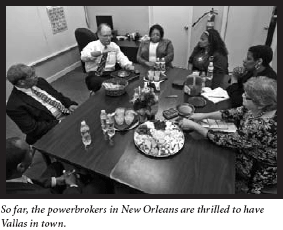
Harrisburg was clear on its favored reform strategy: make Philadelphia a showcase for the private management of low-performing schools. Ridge initially had wanted Edison Schools to run up to 70 low-performing schools in the district and operate the central office under contract.
But Nevels and later the full SRC balked at turning over the management of the district to Edison and at giving all the $75 million in extra state money to private providers. In its first year, the SRC began the process of assigning 45 schools to private providers, Edison and other for-profits as well as some nonprofits, while searching for a new CEO.
When they got Vallas, he immediately began putting his stamp on the “diverse provider” model. He added universities to the mix of school managers. He said he wanted $50 million of the new state money for his own reforms.
“I told them I wouldn’t take the job unless I could get [extra] money for the non–privately managed schools,” he said. As a result, the private managers were left with less than they expected in extra funds to implement their programs, and the all-out experiment originally envisioned by the proponents of privatization there is not what happened.
Using the bond money as a cushion, Vallas began building brand-new schools and doing major renovations on old ones, something that hadn’t happened in decades. He got rid of most middle schools, converting the entire district to a K–8 and 9–12 grade structure. He instituted a standardized curriculum for all subjects and grades. He created afterschool programs, Saturday school, and summer school, the running of which was mostly outsourced to private companies like Kaplan and Princeton Review.
He doubled the number of children in preschool and reshaped the high school landscape. When he started, there were 38 public high schools in Philadelphia with an average enrollment of 1,700. When he left, there were 62, including charters, with an average enrollment of 800; half have fewer than 500 students. One in particular is a monument to his vision, the spectacular School of the Future, a technologically dazzling building designed with Microsoft that serves one of the poorest areas of the city.
Vallas expanded Advanced Placement and International Baccalaureate programs, often in areas more known for gang warfare than academic achievement, while setting up more disciplinary schools and alternative schools for overage underachievers, which were also contracted out to private providers.
Personally, Vallas was all over the place. At SRC meetings, parents who were used to being politely thanked after their carefully timed three-minute speech suddenly found themselves with Vallas at their side getting more information on their complaint. Many mornings, he hung out at schools and talked to parents, teachers, and students as they arrived. At night, he went to neighborhood or church gatherings.
Everywhere, he carried a small notebook and wrote down what people told him. Back in the office, he’d tear out each page and hand it to a cowed aide for attention. Today. Immediately.
“It was on some levels a really wild ride and the best thing that ever happened to the city,” said Ellen Savitz, a veteran district educator who found herself in the twilight of her career with the chance to create five brand-new small high schools, including the School of the Future. “He came into a system where, oh my God, you figured you have to move out when your kid is old enough for school, things are so bad. And he came in full barrel and said, ‘We can do better.’ And he proceeded to do it.”
Teacher recruitment stepped up. Almost all new hires were certified, compared to just three in five when he took over, and more of them stayed beyond their first year. Test scores went up more or less steadily, especially at the elementary level. In 2002, 29 percent of students were advanced or proficient in reading and 19.5 percent in math on the state achievement test, the PSSA. In 2007, 38 percent of students scored at the proficient level in reading, and 41 percent did so in math.
More schools met federal achievement goals. At the start of the Vallas era, just 26 of the district’s 200-plus schools made Adequate Yearly Progress under No Child Left Behind. By the time he left, that number had increased to 166.
It is an impressive record, but his endless array of new programs and initiatives exhausted not only those around him, but the district’s available resources as well. In the beginning, nobody was too concerned about the way Vallas was spending money. He had been the director of the Illinois Economic and Fiscal Commission, the state legislature’s budget arm, and the revenue and budget director for the city of Chicago. He was energizing everyone around him, and he kept presenting budgets that he said were balanced.
“Early on he decided, no guts, no glory,” said Cecilia Cummings, who served as Vallas’s chief communications officer. “He was going to go for broke.”
But for some, “going for broke” meant exactly that: driving the district into deficit while failing to follow up with a serious look at what was working and what wasn’t. In Philadelphia, he outsourced a multitude of services, with little qualm and minimal oversight. In the end, the district had run out of money and had no idea exactly what was responsible for the successes. Parent activists, who both appreciated Vallas and were wary of him, and who clashed philosophically with Whelan and the SRC over reform strategies and privatization, nevertheless came to a similar conclusion. They were concerned too that while test scores were going up in the lower grades and students had more high school choices, 11th-grade scores were still abysmal and the dropout rate, close to 45 percent, hardly budged.
Vallas lobbied for more money from the city and the state, and was only partially successful. “He believed if we could show results, that investment would follow,” said Cummings. “And I think that was his big disappointment and unfortunately his greatest failure, in assuming that the investment would follow.”
The SRC lobbied some as well, but didn’t go to the mat on the question of whether the district was under-resourced by the state and city. Gradually, Vallas’s persona and his initiative-a-day approach began to grate on its members.
“Vallas came in with a lot of promises, a lot of unfocused activity,” said Dan Whelan, the retired chief executive officer of Verizon Pennsylvania who served for five years on the SRC and started out as an enthusiastic supporter. “He had a can-do attitude with a cure for every problem, all of which provided hope for a time. However, in the end he didn’t deliver sustainable change in some very fundamental areas.” Whelan said that while shaking things up, Vallas did little to change a system culture that tolerated lax spending habits, duplication, and absenteeism.
The Breakup
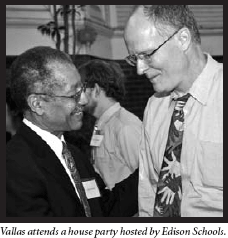
For sure, Vallas is not a bottom-up, capacity-building sort of person. There was no succession planning. He failed to cure many systemic ills. While for most of his term he got along with the Philadelphia Federation of Teachers, he really didn’t move the famously intransigent union on many important issues. Teacher pay for performance, for one. The U.S. Department of Education gave the city a $5 million grant to work out a pilot project, but after months of fruitless negotiations with the union, the district gave up and used the money instead for charter schools.
The beginning of the end of his tenure happened when, just four months after he had told the Philadelphia City Council that the budget was balanced and a month after the SRC, by a 3–2 vote, had renewed his contract until 2010, the district suddenly was revealed to have a $73 million deficit.
“I think Paul relied on the finance team, and the finance team was telling him all along he was spending too much, and he was constantly getting them to stretch the buck, be more creative,” said Fred Farlino, who came out of retirement to be the district’s chief operating officer for part of Vallas’s tenure.
Vallas, said Farlino, “would absolutely stretch it to where it won’t stretch any more. That’s what he was good at, and he drove people crazy, but when you looked around, and saw how he was transforming the district, you’d say, maybe Paul’s right, maybe I’m stuck in the mud.”
Embarrassed SRC members, led by Whelan and James Gallagher, the president of Philadelphia University, pushed for Vallas’s ouster. In the spring of 2007, they took him to lunch at the Four Seasons Hotel and told him that they had lost confidence in him. Nevels, until then a Vallas ally, took their side.
Governor Ed Rendell, a Democrat and former Philadelphia mayor, fought hard to have Vallas stay. “Paul was successful in implementing a menu of strategies aimed at boosting academic achievement, and extraordinary strategies that involved huge organizational change to occur simultaneously,” said Donna Cooper, Rendell’s policy chief. “The standardized curriculum, technology, a robust alternative education pipeline, a culture focused on student scores, closing the teacher shortage, creating new high schools. His gift is successfully implementing numerous strategies at once at a very deep level. A lot of people can say what they want to get done. Paul actually got a lot of it done.”
But after the spring lunch meeting, Vallas had had it. Los Angeles had wooed him and then the offer came from New Orleans. He told Cooper and Rendell that he was out.
Even now, though, Vallas will say that Philadelphia’s budget woes have been overblown, primarily caused by a few bad breaks in the last fiscal year: more retirements than expected that caused a large one-time benefit payout, failure to sell a school building, a delay in state reimbursement for some funds. “The deficit I left on paper was $40 million. The deficit I inherited was $160 million,” he said. “And look at all we did.”
Vallas has no time for criticism that he tried to do too much, too fast. “Look,” he said, “I don’t know what that means, juggling too many balls at once. That’s how we get the type of growth we get; you can’t focus on one thing. Our kids have multiple problems that need multiple solutions, not a magic bullet, but a cocktail.”
If that “cocktail” needs to include programs to address students’ out-of-classroom needs, so be it. You won’t find Vallas philosophically debating the issue of whether schools can reasonably be expected to succeed academically in desperately poor areas before the issues of poverty are addressed.
Nor will he philosophically defend choice and privatization over other strategies, although he says he felt the diverse provider model in Philadelphia was a success, albeit compromised by the decision made by the SRC before his arrival to make the companies work within the existing teacher contract and other rules under a so-called “thin management” arrangement.
“The EMOs didn’t get the autonomy they needed to develop the models they needed to develop,” he says.
He can easily reconcile that with his top-down approach. “I’m about centralized and aggressive intervention, but I support diversity in management models and decentralization for local decision making.”
As CEO, Vallas was tough on the private managers. He fired one company, Chancellor Beacon, barely a year into their contract. He borrowed what he liked; he instituted a version of Edison’s monthly computerized Benchmark testing program for the entire system, and gave some district schools equivalent extra dollars per pupil to see what they could do with more resources. He seemed to prefer charters, recruiting nationally successful models like KIPP, and urging some locally grown ones to open new schools.
Studies of the effects of private management have produced inconsistent conclusions. One report by RAND and Research for Action, a local group, said the privately managed schools did no better than others and weren’t worth the extra investment. But a Harvard study, by Education Next editor Paul Peterson and Matthew Chingos, showed that the public schools managed by for-profit companies were more successful at raising student performance than either the district-run schools or those operated by nonprofit organizations.
“The positive,” Vallas says, “is that they took the worst schools and they made gains comparable to the district as a whole. If you want to be negative, you can say we invested more money in them, but the schools didn’t perform better than the district schools. The bottom line is, I think the EMOs proved to be a good whipping boy…the rest of the school district benefited from a substantial amount of additional money the EMOs brought in.”
The Next Challenge
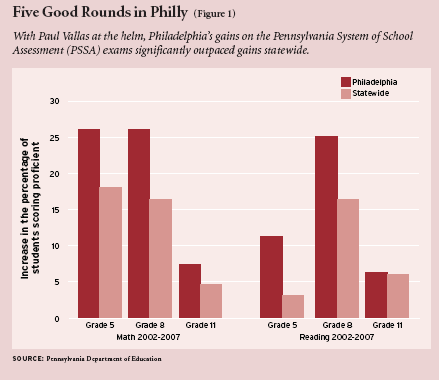
For certain, Vallas saw poverty before arriving in New Orleans. “I had some schools in Philly, more than half the kids were not being raised by their biological parent.” In New Orleans, he says, “the hurricane intensified the trauma, and I have to make adjustments for that.” He recites his litany of remedies: the longer school day and year, a managed, standardized instructional program, and so forth, but he also adds “more counselors, mentors, more school-based behavioral health services, obviously you have to bring more resources to the schools to provide for the needs of the children.”
Vallas now sits in a tiny, unadorned office in the Recovery School District headquarters. It is a former warehouse painted yellow, brick-red, and green and flanked by an abandoned commercial site and a new post office, across a potholed street from several boarded-up houses that form the landscape of what is now New Orleans. The single metal door that people enter to register their children is pockmarked with rust. There are no nameplates on the office doors, just Scotch-taped paper announcing the room number. Staffers bring lunch, because there is no place within walking distance to buy food.
From here, Vallas directs 39 schools with 14,000 students and supervises another 26 charter schools. (The Orleans Parish School Board is in control of 7 schools plus 12 charters, some of which operate under the Algiers Charter Schools Association.) He is again in the middle of a devastated city, trying to mesh his litany of top-down remedies with private management and charters.
He hardly ever sits still. On this day, he has taken a pill to calm him for an airplane trip that he ultimately decides not to take, and at 6’5″ seems confined by the room. In the Crescent City, he lives with his oldest son, Paulie, who has just graduated from high school, in a spare apartment not far from the Convention Center; his wife Sharon and three other sons are back in Chicago.
Working 12- to 16-hour days, and demanding the same of his staff, he caroms from his office to schools to working lunches to meetings to evening events. The warren of narrow, barren hallways and small rooms is constantly in motion. In one room, Gwen Morris and another Philadelphia recruit, Nilsa Gonzales, are crunching the numbers to get an afterschool program going. In another, Deputy Superintendent Kyle Wedberg, who also worked in Philadelphia, is trying to figure out how to handle the delicate problem of cutting teachers, many of whom worked in New Orleans before the hurricane but have failed to meet certification requirements. People run from one office to the next, phones to ears and papers in hand. In addition to whatever they are doing, they must be poised at a moment’s notice to respond to Vallas’s latest command. The sense of urgency is palpable.
On an October Tuesday, shortly before he must submit a spending plan to BESE, Vallas presides over a staff meeting. Most everyone else is bent over a BlackBerry, notebook, or laptop, taking notes on what Vallas wants. He sits at the head of the table with one foot on his chair, knee drawn to his chin. From this posture, he barks orders.
“Get Dell on the phone and set up training dates for teachers to use the new EPIC computers the district has been promised. Hold any payment until they’re set.”
He switches gears. “I’m trying to get the state to understand that we can’t open ten new charter schools in a year. We’re almost at the saturation point.” Then, “We need space for preschool kids with disabilities.”
Next, he’s on to alternative schools. “Give me Abraxas,” he says, referring to a company hired in Philadelphia to deal with elementary-age offenders. “We have kids under indictment for murder who are in elementary school. That’s a concern here.”
He exhorts everyone to be on the hunt for sources of funds. “You know what I want, as we manage this, we all have to be budget directors in our own right.”
As he talks about all his programs, he gets more urgent. He points out that between 50 and 60 percent of the students have failed LEAP, Louisiana’s state test. “Kids are giving up, they don’t think they can pass the LEAP exam. God, only 38 percent graduate…they’re leaping off a cliff. If you think I’m off the reservation here, let me know.”
On the way back from a working lunch, Vallas spies a young boy sitting in the back of a police cruiser in front of a school. Like a shot, he’s out of the car and into the school, commandeering the principal’s office, finding out that the boy hit a teacher, telling her that she’ll soon get a “climate manager” to help deal with the traumatized families of children like this. He gets out his cell phone and orders Eddie Compass to get to the school, pronto.
Compass, the former New Orleans police chief, soon materializes at Vallas’s side. Later, Compass explains how he had a low-pressure, high-paying consulting job when Vallas changed his life in a ten-minute hallway conversation. “He’s probably the most incredible man I ever met,”Compass remarks. “He said, ‘We need people who will make a difference.’ If he as an outsider is doing this, how can people who live in the city not help him?”
That evening, Vallas attends a house party hosted by Edison Schools, which has been hired by the Broadmoor Improvement Association to operate a charter school in the neighborhood. He mutters as he goes in that he would like to see more charters; a few weeks later, he will announce that he wants to give all principals more autonomy next year.
At the party, Vallas is treated like a rock star. “He’s bringing us world-class experience and knowledge,” said Phyllis Landrieu, president of the New Orleans Parish School Board. “He’s been at the top of the world in education, and he knows how to show us the way.”
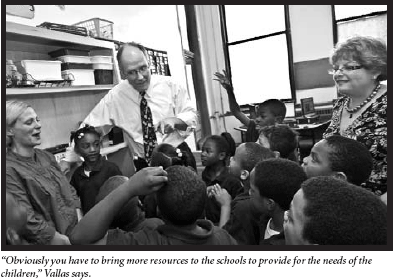
Cheryllyn Branche is principal of the Banneker Elementary School and one of the few veteran New Orleans educators welcomed back into the system. Like other New Orleans natives, Branche lost her home to Hurricane Katrina. Though she likes Vallas and is attracted to his energy and commitment, she questions whether he is thinking through his policies and initiatives. For instance, does after-school make sense in a district where there are hardly any neighborhood schools, many parents don’t have cars, and public transportation is spotty?
“Resources are being pushed to the school level. That’s something that never happened before,” she said. But she worries whether the specific programs these dollars are funding are the right kinds of initiatives. “The EPIC computers, technology, how much difference will they make if the teachers don’t know how to use them?”
In New Orleans, she adds, “Paul Vallas faces challenges I’m sure he’s never had.”
When Vallas unveiled his two-year spending plan in late October 2007, it included laptops for every high school student, interactive “whiteboards” for every classroom from grades 4 through 12, an extended day, class size no larger than 20 in elementary school and 25 in high school, and special programs for academically lagging 8th graders. BESE members—his bosses—were concerned how he could pull this off with the available dollars. Vallas allayed their fears, but by December the RSD was facing a cash crunch brought on partly by spending on his initiatives and partly by school construction costs not immediately reimbursed by FEMA. With benchmark tests showing that 80 percent of students were reading below grade level, he declined to save money by laying off teachers, preferring to rely on his seasoned financial team to balance the books while retaining crucial educational services.
“We opted,” he told the New Orleans Times-Picayune, “to put children ahead of cash flow.”
Dale Mezzacappa covered education for the Philadelphia Inquirer between 1986 and 2006 and is now a freelance writer.


